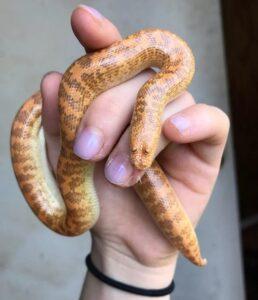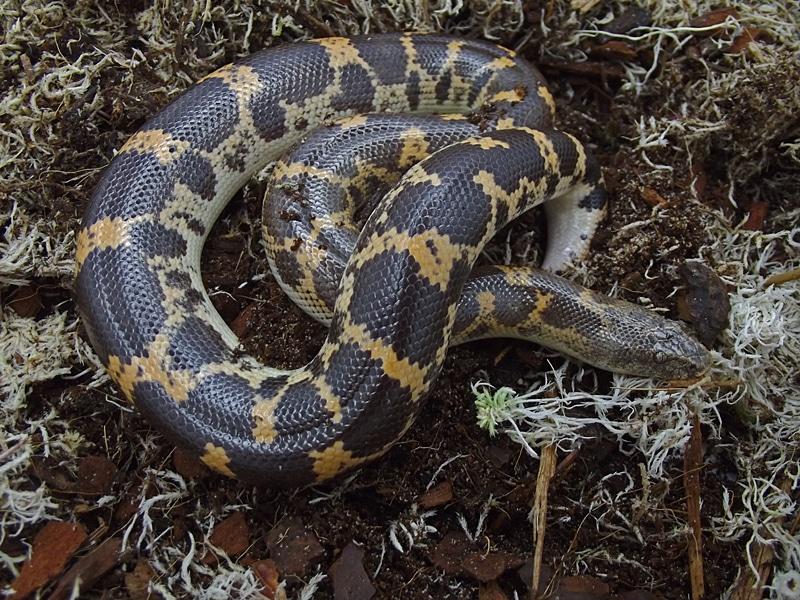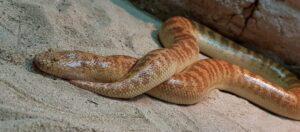
The Arabian sand boa, or Jayakar’s sand boa, is a small, mostly nocturnal snake species native to the Arabian peninsula. One of its common names and its specific name, jayakari, is in honor of the Indian surgeon and naturalist, Atmaram S. G. Jayakar (1844-1911). They are solitary creatures that come together only during mating season.
Conservation Status
Description
Size
The boa attains a total length of about 15 inches (38 cm). It can weigh up to 3.5 oz.
Color and Appearance
The color of the boa is sandy-brown or yellowish-gray with white speckles and dark transverse bands. Its belly is yellowish or whitish.
The eyes of the Arabian sand boa are tiny and placed on top of the wedge-shaped head that has a blunt snout. The location of the eyes is an adaptation to its habitat and burrowing nature.
Are They Dangerous to Humans
The calm, shy and nervous snake doesn’t show aggression but strikes if it feels threatened. Its strike is not straight but sideways, so it might catch one unawares. But being non-venomous, it can’t cause any harm.
The pets do well with careful handling. But they may strike if they feel grumpy or mistake your finger for their food.
Arabian Sand Boas at a Glance
Distribution
The species inhabits Saudi Arabia, Yemen, Oman, southern Iran, and Kuwait (Khuzestan, Bushehr, and Kerman provinces).
Habitat
The desert species of snake lives semi-underground in sand or soft soil. It is tolerant to an extensive range of temperatures.
During the day, it buries itself deep under the sand and comes towards the surface at dusk. It remains a little below the surface with just its eyes peeping out so that it can pounce on its prey with a swift sideways flick of its head.
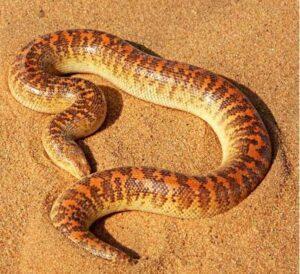
Lifespan
Its average lifespan is 20 years.
Predators
Birds of prey and bigger snakes prey on the Arabian sand boa.
Diet
The Jayakar’s sand boa, an ambush predator, eats Baluch rock geckos, short-fingered geckos, and worms.
Reproduction
Oviparous (lays eggs that hatch outside the body)
The females lay a small clutch of 4-7 eggs that hatch in around 66 days when kept at a temperature of 91°F.
Similar Species
Kenyan Sand Boa (Eryx colubrinus): It has a cream or snow-colored venter. Its pattern is not as dark and refined as the Arabian sand boa.
Care Sheet
Size of the Enclosure: The ideal size of the cage is 20 inches (length) x 10 inches (width) x 10 inches (height).
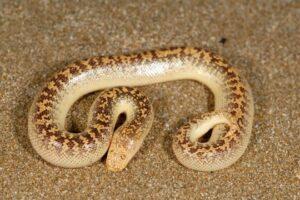
Temperature: The cool side of the tank should be at 75°F, while the warm side temperature should be 85°F. The basking spot should be maintained at 90°F.
Humidity: A 40% humidity level is ideal for the snake. A non-porous water bowl should be kept in the cool side of the enclosure.
Substrate: Butcher’s paper, paper towels, or newspaper are great options for the substrate. A sand-based substrate is not recommended as it can be ingested by the snake, causing fatal digestive problems.
Feeding: Mice, small rats, or lizards are appropriate food for your pet. Feed the babies one prey item weekly, and the adults can have the same number of food items every 10-14 days.
Source
critter.science, 64.media.tumblr.com, reddit.com, researchgate.net

